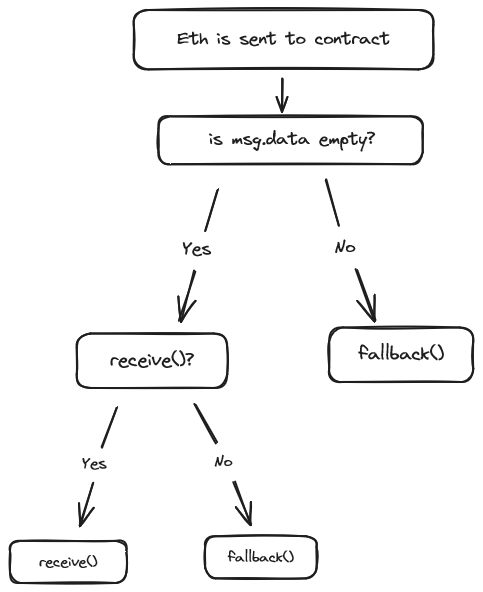_Follow along with the video_ --- In the world of Solidity smart contracts, it's important to understand the fallback and receive functions. By default, Solidity smart contracts reject any Ether (ETH) sent to them. In order to enable your contract to accept ETH, we would implement `fallback` and `receive` functions. Let's look at these more closely. ## What are the Fallback and Receive functions? These two specific functions - `fallback` and `receive` - enable a contract to accept and react to native ETH sent to it. Both these functions can be made "**external payable**", indicating that they can receive and handle ETH. So, how do they function? Here's the core logic to give you a better understanding:  To put it simply, consider the case of sending ETH to a smart contract without any data. In such an instance, the `receive` function would be called, resorting to `fallback` if the `receive` function does not exist. On the other hand, if there _is_ data, Solidity will skip straight to the `fallback` function, bypassing the `receive` function entirely. ## Default Settings in Solidity It is worthwhile to note that the `fallback` function may or may not be payable. If the contract lacks a `receive` function and the `fallback` function isn't payable, then the `fallback` function won't be called when you send ETH to the contract. ```js fallback() external{} receive() external payable {} ``` By the same token, a contract that does not contain any of these functions will reject any ETH sent to it. In fact, Solidity will automatically compile this contract to reject ETH - with at least one notable exception we'll go over later. ## Deepening Understanding: Encoding The next lesson is a clip you might remember from the Foundry Course. We're going to go over encoding and explain how it can be used to call any function on any contract from another contract. Let's do it.
Follow along with the video
In the world of Solidity smart contracts, it's important to understand the fallback and receive functions. By default, Solidity smart contracts reject any Ether (ETH) sent to them. In order to enable your contract to accept ETH, we would implement fallback and receive functions. Let's look at these more closely.
What are the Fallback and Receive functions?
These two specific functions - fallback and receive - enable a contract to accept and react to native ETH sent to it. Both these functions can be made "external payable", indicating that they can receive and handle ETH.
So, how do they function? Here's the core logic to give you a better understanding:

To put it simply, consider the case of sending ETH to a smart contract without any data. In such an instance, the receive function would be called, resorting to fallback if the receive function does not exist.
On the other hand, if there is data, Solidity will skip straight to the fallback function, bypassing the receive function entirely.
Default Settings in Solidity
It is worthwhile to note that the fallback function may or may not be payable. If the contract lacks a receive function and the fallback function isn't payable, then the fallback function won't be called when you send ETH to the contract.
By the same token, a contract that does not contain any of these functions will reject any ETH sent to it. In fact, Solidity will automatically compile this contract to reject ETH - with at least one notable exception we'll go over later.
Deepening Understanding: Encoding
The next lesson is a clip you might remember from the Foundry Course. We're going to go over encoding and explain how it can be used to call any function on any contract from another contract.
Let's do it.
Fallback and Receive
Learn about the fallback and receive functions in Solidity. Investigate how these functions influence smart contract functionality.
Previous lesson
Previous
Next lesson
Next
Duration: 25min
Duration: 1h 18min
Duration: 35min
Duration: 2h 28min
Duration: 5h 03min
Duration: 5h 22min
Duration: 4h 33min
Duration: 2h 01min
Duration: 1h 40min